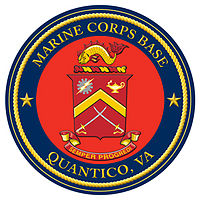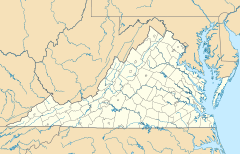- Marine Corps Base Quantico
-
Marine Corps Base Quantico Quantico, Virginia 
MCB Quantico logoType Military base Built 1917 In use Officer Candidates School
The Basic School
Marine Corps University
FBI Academy
Drug Enforcement Administration training academyControlled by United States Marine Corps Current
commanderColonel Daniel J. Choike Commanders John A. Lejeune Quantico Marine Corps Base Historic DistrictCoordinates: 38°33′3.9594″N 77°25′50.1594″W / 38.551099833°N 77.430599833°WCoordinates: 38°33′3.9594″N 77°25′50.1594″W / 38.551099833°N 77.430599833°W Governing body: United States Marine Corps NRHP Reference#: 01000260 Added to NRHP: March 26, 2001 Marine Corps Base Quantico, sometimes abbreviated MCB Quantico, is a major United States Marine Corps training base located near Triangle, Virginia, covering nearly 100 square miles (260 km2) in southern Prince William County, northern Stafford County, and southeastern Fauquier County. The base is known as the "Crossroads of the Marine Corps."[1]
The Corps' Combat Development Command, which develops strategies for Marine combat and makes up most of the community of over 12,000 military and civilian personnel (including families) is based here. It has a budget of around $300 million and is the home of the Marine Corps Officer Candidates School. The Marine Corps Research Center at Quantico pursues equipment research and development, especially telecommunications, for the Marine Corps. The Marine Corps Brig, a military prison, is also located at Quantico.
The FBI Academy, the principal research and training facility of the Federal Bureau of Investigation, and the principal training facility for the Drug Enforcement Administration (DEA) are also located on the base. The National Museum of the Marine Corps is located near the base.
The base as designated as part of the Quantico Marine Corps Base Historic District by the National Register of Historic Places in 2001.[2][3][4] This district includes 122 buildings, two landscapes, a sculpture, and a water tower located within the Mainside area of the base.[5] The contributing properties with separate entries include Tennessee Camp, Camp French, Commanding General's Quarters, and Rising Hill Camp.
Contents
History
Before the Establishment of the Marine Base
The Quantico base is close to the Potomac River. The area was originally inhabited by the Patowomacks (Algonquian) in the 16th century. The name "Quantico" is credited to come from a Native American term, and has been translated to mean "by the large stream." Accounts show that the area was first visited by European explorers in the summer of 1608 with settlement beginning later that year.
After the turn of the century, the area became popular because of tobacco trade in Aquia Harbor. Because traveling on muddy roads in those days was slow, many villages sprung up along the river and its inlets. Additionally, the area was a bustling stopping point on the north-south routes between New York and Florida.
Early settlements and plantations rooted along the flatlands bordering the Potomac. The hills west of the river remained essentially uninhabited until the early 18th century. Prince William County was organized in 1731, when the "Quantico Road" was also opened. This road gave vital access from the western part of the county to this area. By 1759, the road stretched across the Blue Ridge Mountains into the Shenandoah Valley.
The first military presence at Quantico came during the American Revolutionary War, when the Quantico Creek village became a main naval base for the Commonwealth of Virginia's 72-vessel fleet on which many state militia served.
The land was first visited by the Marine Corps in 1816, when a group of Marines traveling by ship to Washington were stopped when their vessel was halted by ice in the Potomac, forcing them to debark and march to the town of Dumfries, Virginia. Here they met a young Captain Archibald Henderson who lived close by. A generous-natured man, Henderson hired a wagon for them and sent them on their way.
During the Civil War, control of the Potomac River became very important to both sides of the two armies. The Confederates picked the Quantico Creek area on the Potomac to set up their gun batteries. This enabled them to make full use of several points where their artillery could reach anything on the water, thus deterring Union use of the water highway. One of these sites included "Shipping Point," the present day site of the Marine Corps Systems Command.
While battles took place in Manassas, Virginia and Fredericksburg, Virginia, the gun positions around Quantico were used until the end of the war. After a 12-day battle at the Spotsylvania Courthouse where the Union lost about 25,000 soldiers, the war moved out of the Quantico area.
Following the war, railroads became a more integral part of transportation. In 1872, the Richmond, Fredericksburg and Potomac Railroad was formed when several railroads north and south met at Quantico Creek. This railroad still runs through the Base and is used daily.
The village came to be called "Quantico" and was built by the Quantico Company. This was the start of a thriving tourist and fishing town that would later be encompassed by Marine Corps Base Quantico.
Establishing the base
Prior to the base's establishment, the land was owned by the Town of Quantico. At the turn of the century, the Quantico Company was formed on Quantico Creek. The company, which promoted the town as a tourist and excursion center, set up tourist sites, such as refreshment stands, boats, and beaches with dressing rooms to promote business.
By 1916, the Quantico Company began advertising Quantico as "The New Industrial City," and pushed for industry to come to the area. At the same time, the Quantico Shipyards were established on Hospital Point (the land that formerly held the Naval Medical Clinic but is now home to Marine Corps Systems Command) to build ocean freighters and oil tankers. With growing tensions of war in Europe, the construction of U.S. Navy ships was a major money-maker for the Quantico Shipyards. While the Town of Quantico was rapidly growing as a fishing village, excursion center and a shipbuilding center in early 1917, the town was not large or significant, and was suffering many financial difficulties.
Around the same time, Major General George Barnett, then Commandant of the Marine Corps, sent a board to find possible sites for a new Marine Corps base in the Washington, D.C., vicinity.
In 1917, Marine Barracks, Quantico was established on the land currently occupied by today's base. Marine Barracks personnel consisted of 91 enlisted men and four officers. Thousands of Marines were trained here during World War I. By 1920, the Marine Corps schools were founded, as Colonel Smedley Butler put it, "to make this post and the whole Marine Corps a great university."
These schools eventually developed into today's Marine Corps University. Virtually all Marine officers receive their basic training here, as well as enlisted technicians from many different disciplines.
The first Marine Aircraft Wing was developed at Quantico, as well as the Corps' first helicopter squadron, Marine Helicopter Squadron One (HMX-1), the first helicopter squadron to provide rapid transportation for Presidents of the United States ("Marine One"). It continues that mission today.
In 1934, Amphibious Warfare Doctrine, along with special amphibious landing crafts for World War II were developed here.
In 1987, the Marine Corps Development and Education Command here was changed to the Marine Corps Combat Development Command.
A soldier accused of disclosing classified information was detained in the Quantico brig in 2010-2011. Demonstrators blocked a gate on Sunday, March 20, 2011. 30 were arrested.[6]
Units and commands
It is the site of the Marine Corps Combat Development Command and Marine Helicopter 1 HMX-1. HMX-1 was the first helicopter squadron to provide rapid transportation of U.S. Presidents, a mission they have continued to carry out to the present day.
- Marine Corps Embassy Security Group
- Marine Corps Marathon
- Marine Corps Combat Development Command
- Marine Corps Recruiting Command
- Manpower and Reserve Affairs Division, Headquarters Marine Corps
- Marine Corps Systems Command
- Marine Corps Training and Education Command
- The Basic School
- Marine Air-Ground Task Force (MAGTF) Staff Training Program
- Marine Corps University
- Officer Candidates School
- Marine Corps Network Operations Security Command
- Marine Corps Wounded Warrior Regiment
Tenant activities
The base is the home of major training institutions for both the Marine Corps and federal law enforcement agencies, including:
- Drug Enforcement Administration training academy
- FBI Academy
- The FBI Laboratory
- FBI Hostage Rescue Team (HRT)
- Marine Raider Museum
- Naval Criminal Investigative Service Headquarters, Army CID Headquarters, AFOSI Headquarters.
- Defense Intelligence Agency
A replica of the USMC War Memorial, depicting the flag-raising at Iwo Jima, stands at the entrance to the base. (The original stands at the north end of Arlington National Cemetery.)
Marine Corps Base Quantico and the Potomac River surround the town of Quantico. Access to the town is possible only through the base, the Amtrak train station or from the river.
See also
References
 This article incorporates public domain material from websites or documents of the United States Marine Corps.
This article incorporates public domain material from websites or documents of the United States Marine Corps.- ^ Fleming, LtCol Charles A.; Capt Robin L. Austin, and Capt Charles A. Braley III (1978). Quantico: Crossroads of the Marine Corps. Washington, D.C.: History & Museums Division. http://www.tecom.usmc.mil/HD/PDF_Files/Pubs/Quantico-%20Crossroads%20Of%20The%20Marine%20Corps.pdf.
- ^ "National Register Information System". National Register of Historic Places. National Park Service. . http://nrhp.focus.nps.gov/natreg/docs/All_Data.html.
- ^ "Quantico Marine Corps Base Historic District". National Register of Historic Places. National Park Service. http://pdfhost.focus.nps.gov/docs/NRHP/Text/01000260.pdf. Retrieved 21 March 2011.
- ^ "Quantico Marine Corps Base Historic District". National Register of Historic Places. National Park Service. http://pdfhost.focus.nps.gov/docs/NRHP/Photos/01000260.pdf. Retrieved 21 March 2011.
- ^ "MCB Quantico - NREA - Cultural Resources". United States Marine Corps. http://www.quantico.usmc.mil/activities/display.aspx?PID=1695&Section=NREA. Retrieved 2008-08-06.
- ^ Birnbaum, Michael (22 March 2011). "Protesters arrested near Quantico as rally for alleged WikiLeaks source turns tense". Washington Post. http://www.washingtonpost.com/world/protesters-arrested-at-quantico-as-rally-for-alleged-wikileaks-source-turns-tense/2011/03/20/AB39JP3_story.html. Retrieved 2011-03-21.
External links
- MCB Quantico website
- The National Museum of the Marine Corps
- USMC Base Quantico Overview & PCS Information (MarineCorpsUSA.org)
Operational military installations of VirginiaDepartment of Defense  Headquarters
Headquarters
Army  FortCampPlantRadford Army Ammunition Plant
FortCampPlantRadford Army Ammunition PlantMarines  Air StationMarine Corps Base QuanticoHallHenderson Hall
Air StationMarine Corps Base QuanticoHallHenderson HallNavy  StationShipyardNAS OceanaMedical CenterSchoolFleet Training Center Dam Neck
StationShipyardNAS OceanaMedical CenterSchoolFleet Training Center Dam NeckAir Force 
National Guard  Langley AFBState ReserveSchool
Langley AFBState ReserveSchoolCoast Guard 
Andrews Air Force Base · Bolling Air Force Base · Fort Belvoir · Fort McNair · Fort Meade · Fort Myer · Henderson Hall · Marine Corps Base Quantico · Naval Support Facility Anacostia · Pentagon · Washington Navy Yard
U.S. National Register of Historic Places Topics Lists by states Alabama • Alaska • Arizona • Arkansas • California • Colorado • Connecticut • Delaware • Florida • Georgia • Hawaii • Idaho • Illinois • Indiana • Iowa • Kansas • Kentucky • Louisiana • Maine • Maryland • Massachusetts • Michigan • Minnesota • Mississippi • Missouri • Montana • Nebraska • Nevada • New Hampshire • New Jersey • New Mexico • New York • North Carolina • North Dakota • Ohio • Oklahoma • Oregon • Pennsylvania • Rhode Island • South Carolina • South Dakota • Tennessee • Texas • Utah • Vermont • Virginia • Washington • West Virginia • Wisconsin • WyomingLists by territories Lists by associated states Other Categories:- Historic districts in Virginia
- United States Marine Corps bases
- Military facilities in Virginia
- National Register of Historic Places in Virginia
- Buildings and structures in Fauquier County, Virginia
- Buildings and structures in Prince William County, Virginia
- Buildings and structures in Stafford County, Virginia
- 1917 establishments in the United States
Wikimedia Foundation. 2010.




